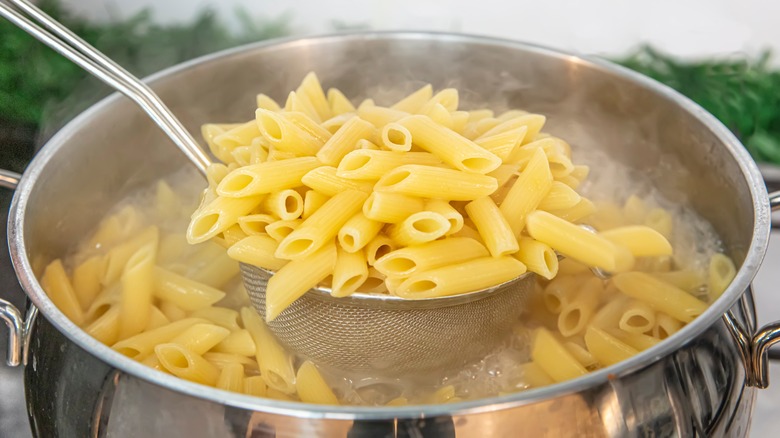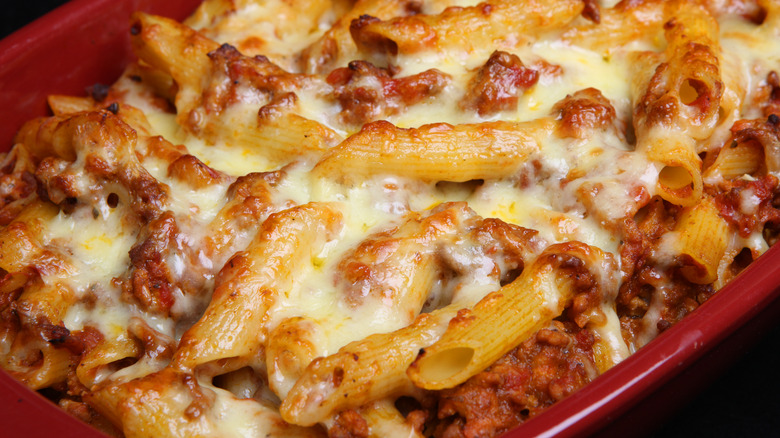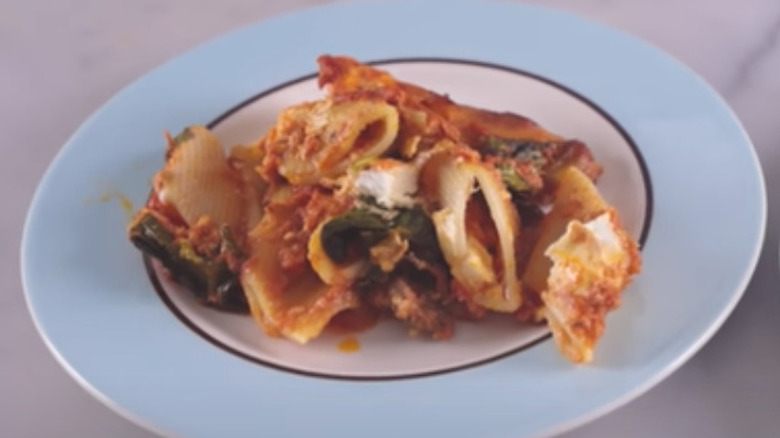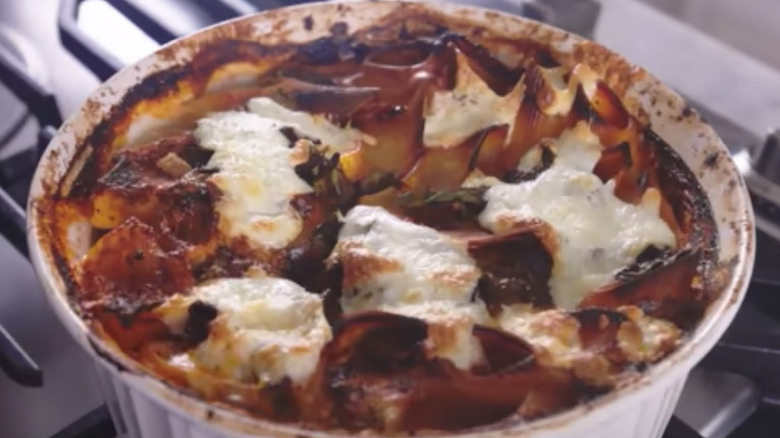Why You Should Stop Pre-Boiling Pasta When Using It For This
Pasta is one of Italy's best-known and best-loved foods and an easy, delicious meal. While fresh pasta is delicious and indulgent, most people opt for dried pasta when it comes to everyday cooking. The traditional way is to cook your dried pasta in abundant, boiling, salted water until it's al dente (ever so slightly undercooked), and then drain it (via She Loves Biscotti). You add the cooked pasta to the sauce you're serving it with (potentially, adding a bit of the water it's boiled in) so that the pasta and sauce pair happily.
While fresh pasta barely needs boiling (per Paesana), it's obvious why you need to cook dry pasta: Before its water bath, it's hard and crunchy (not in a good way), suitable mostly for children's art projects, not for unctuous sauces.
But one of the great advantages of pasta dishes is the opportunity to get a vegetable, protein, and carb source into one magical meal. What if you could avoid the extra pot for boiling your pasta in and cook your dried pasta in its sauce instead of adding it afterward? That would eliminate both an extra pot and the extra time for boiling the water and your pasta.
The short answer? You can. Adam Ragusea has done some impressive experiments with baked pasta dishes and has found a way to adjust any baked pasta recipe so that your noodles are cooked through, without pre-cooking them.
The Ragusea methodology for baked pasta
When you're preparing baked pasta (known as "pasta al forno" or "oven pasta" in Italian), your pasta and its sauce are ending up in a hot oven for over half an hour, though the exact timing depends on the dish. When you figure that boiling your pasta takes only about 10 minutes or so, it seems like the baking time should be used for cooking the pasta, too, no?
Sì! But the problem is moisture. Ovens are dry heat and pasta is already dry, so you need to supply enough moisture to rehydrate your pasta (per OregonLive). This is where things get a bit dicey, and where you can end up with saucy, crunchy pasta if you don't precook your noodles, which is a sad fate of affairs. So what does Ragusea do?
It's a genius move in its simplicity: He follows the original recipe to the letter but then tops the completely prepared pasta dish with a pinch of salt and "just enough water to cover everything" (via YouTube). You can just eyeball the amount of water; but, if you prefer to measure it, you should add two times the pasta's weight in water to the top. The water supplies the additional hydration, and the salt is there to supply the extra you'd get from cooking your pasta in salted boiling water. The dish cooks just the same, though Ragusea suggests you give it a few more minutes of cooking time than its water-free counterpart.
Testers' notes, alternatives, and takeaways
To support his claims, Ragusea tested his method out on video and showed us how he proceeded (per YouTube). He made three identical batches of the same recipe, but he dealt with the ziti in three different ways: one set he boiled per directions; one set he did not cook at all and added straight to the recipe; and the third was the pasta that got the layer of water over the top.
What did Ragusea conclude from these experiments? The first set was very good, the second set too hard, and the third was ... drum roll ... just right since it saved time, fuss, and energy. Ragusea noted that this method will result in more heavily flavored noodles since the pasta cooks directly and exclusively in its sauce: You can see the difference in color between the pasta that cooked in water first (and, therefore, absorbed less of the sauce) compared to the "saucy" pasta. But other than that, it's mostly indistinguishable from the "regular" way of making it.
Ragusea is pretty convincing, but if you're not sold, there is another approach you can take, too, which Sara Moulton endorses (via OregonLive). She found it hard to figure out a good gauge for parboiling pasta and considered fully pre-boiled pasta too mushy after baking for her liking. Her solution? She soaks the pasta in warm salted water for 45 minutes before adding it to its sauce and popping it in the oven.
Additional perks of the no-boil approach
But Ragusea's insights don't stop there (per YouTube). Empowered by this discovery, Ragusea whittled down the bowls, pots, and steps even further. He whipped up a deconstructed batch of baked pasta goodness, showing us how to make a fridge clean-out baked pasta in one pot.
How did he work this culinary miracle? First, he sliced up a shallot directly into his baking dish and added some greens that were lingering at the bottom of his produce drawer. Next, he put in some canned crushed tomatoes, all the while uttering words of comfort for those of us unsure about whether this wacky approach would really turn out alright. A bit of bresaola was next — but Ragusea insisted that any thin-sliced cured meat would be a fine addition. Then came some mozzarella and seasoning: salt, butter, chili flakes, and grated Parmesan. Lastly, Ragusea put in as much pasta "as he can fit" into the dish, and added his liquid — this time, a mix of water and white wine. He baked it for an hour and then added a little more mozzarella to the top for good measure.
So many options. But whichever way you make it, there are still fewer dishes and less work in the equation, which equals better food, better life.



